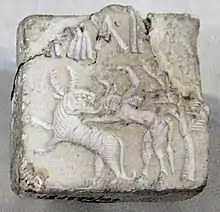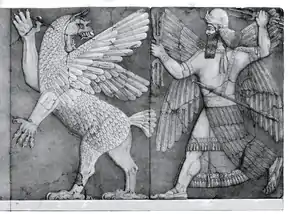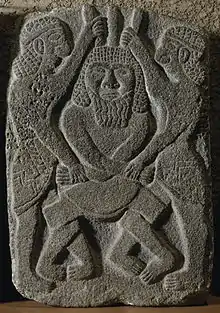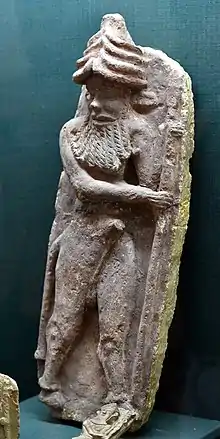Enkidu
Enkidu (Sumerian: 𒂗𒆠𒄭 EN.KI.DU10)[6] was a legendary figure in ancient Mesopotamian mythology, wartime comrade and friend of Gilgamesh, king of Uruk. Their exploits were composed in Sumerian poems and in the Akkadian Epic of Gilgamesh, written during the 2nd millennium BC. He is the oldest literary representation of the wild man, a recurrent motif in artistic representations in Mesopotamia and in Ancient Near East literature. The apparition of Enkidu as a primitive man seems to be an innovation of the Old Babylonian version (1300 - 1000 BC), as he was originally a servant-warrior in the Sumerian poems.
 Representation of Enkidu (2027-1763 BCE)[1] | |
| Grouping | Mythic humanoids |
|---|---|
| Sub grouping | Wild man |
| Country | Uruk |
| Region | Sumer |

| Part of a series on |
| Ancient Mesopotamian religion |
|---|
 Chaos Monster and Sun God |
| Related topics |
There have been suggestions that he may be the "bull-man" shown in Mesopotamian art, having the head, arms, and body of a man, and the horns, ears, tail and legs of a bull.[7] Thereafter a series of interactions with humans and human ways bring him closer to civilization, culminating in a wrestling match with Gilgamesh, king of Uruk. Enkidu embodies the wild or natural world. Though equal to Gilgamesh in strength and bearing, he acts in some ways as an antithesis to the cultured, city-bred warrior-king.
The tales of Enkidu’s servitude are narrated in five surviving Sumerian poems, developing from a slave to a close comrade by the last poem, which describes Enkidu as his friend.[8] In the epic, Enkidu is created as a rival to king Gilgamesh, who tyrannizes his people, but they become friends and together slay the monster Humbaba and the Bull of Heaven; because of this, Enkidu is punished and dies, representing the mighty hero who dies early.[9] The deep, tragic loss of Enkidu profoundly inspires in Gilgamesh a quest to escape death by obtaining godly immortality.[10]
Enkidu has virtually no existence outside of the stories relating to Gilgamesh. As far as we know, he was never a god to be worshiped, and is absent from the lists of deities of ancient Mesopotamia. It seems to appear in an invocation from the Paleo-Babylonian era aimed at silencing a crying baby, a text which also evokes the fact that Enkidu would be held to have determined the measurement of the passage of time at night, apparently in relation to his role as herd keeper at night in epic.[11]
Etymology
The name of Enkidu is Sumerian, and generally written in texts in this language by the sequence of signs en.ki.du10. The phrase ki.du10 (good place) is well attested in the Early Dynastic personal names, and the name en.ki.du10.ga (Lord of the good place) is cited on the Fara tablets. The lack of genitive or any grammatical element was common until the late third millennium.[12] However an alternate translation has been proposed as Creation of Enki.
In the epic, his name is preceded by the determinative sign of the divinity dingir 𒀭, which means that this character was considered to be of divine essence.
Sumerian poems
_(cropped).jpg.webp)
"The envoys of Agga"
Uruk refuses to participate in the digging of wells for the benefit of Kish, whose kingdom had the hegemony of Sumer. Its king Agga submits the city to a siege. Enkidu is sent to prepare the weapons and wait for Gilgamesh's order. After the battle, Gilgamesh defeats Agga, and makes him return, defeated and humiliated, to Kish.[14]
"The lord to the Living One's Mountain"
Gilgamesh, disturbed by the death of his subjects and by the brevity of human existence, decides to make a rename of himself. The king of Uruk and Enkidu make an expedition to the Forest of the Cedars, where, with Utu's blessing, they traverse seven mountains. Enkidu warns the king that the monster Huwawa inhabits the mountain region, armed by seven supernatural Auras. However, Gilgamesh has no fear, his fifty men cut the trees, until Huwawa appears. Gilgamesh offers him seven gifts in exchange for leaving his seven Auras, but it is a trap. He strikes Huwawa several times, who asks for mercy. Gilgamesh softens his heart, nevertheless, Enkidu decapitates the monster. Enlil reproaches them for his death, and distributes the seven auras to the fields, the rivers, the reed-beds, the lions, the palace, the forest and Nungal, which would explain the fear and fascination they give to the humans.[15][16]
"Hero in battle"
Inanna is enraged with Gilgamesh, she forbids him from administering justice in her temple, the Eanna, causing unrest in the environment of the King of Uruk. Finally, Inanna demands, with threats, from her father the Bull of Heaven to kill Gilgamesh. The bull is released in Uruk, whose insatiable hunger destroys crops and rivers. Enkidu grabs the bull by his tail and Gilgamesh smashes its head. Finally they distribute the meat among the poor and transform the horns into cups for ointments for the Eanna.

"Gilgamesh, Enkidu, and the Netherworld"
An oak tree grows on the banks of the Euphrates, the south wind blows it away and the goddess Inanna gathers it, planting it in her garden to use her wood as a throne. Suddently, a snake takes refuge between its roots, a giant eagle on its top and a female demon between them. Inanna asks her brother Utu for help, in vain, and then Gilgamesh. He cuts the tree, kills the serpent, expels the eagle to the mountain and the devil to the desert. Inanna gives Gilgamesh a drum (ellag) and drumsticks (ekidma), in some versions a rod and a ring. Eventually they end up falling to the Netherworld. Enkidu offers to rescue them, but not before receiving explanations from Gilgamesh on how to behave in hell, to not seem alive in the residence of the dead. Enkidu however, ignores them; consequently, Enkidu ends up being held forever in the Netherworld. Gilgamesh's pleas to the gods to set him free, Enki finally causes the shade of Enkidu to rise to briefly reunite with Gilgamesh. The latter interrogates who from now on calls his "friend", the fate of the dead, Enkidu answers each of your questions. The text is lost here.[17]
Did you see him who fell in battle?
I saw him [...] his father and mother are not there to hold his head, and his wife weeps.
"The great wild bull is lying down"
Gilgamesh is dying. The gods judge his exploits, after his position as future judge of the underworld has been revealed to him, he offers gifts and sacrifices to the gods. Then he takes comfort in the words of the gods; after death, he will be reunited with his family, his priests, his warriors and his best friend, Enkidu. Finally, he dies.[18]
Epic of Gilgamesh
The Akkadian epos is found in various versions from Surpassing all other kings (c. 1800 – c. 1600) and He who saw the Deep (c. 1300 – c. 1100), which was compiled by Sin-liqe-unninni from earlier texts, later discovered in the Library of Ashurbanipal in 1853.
Creation of Enkidu
Gilgamesh, king of Uruk, abuses his people. In response to complaints from the citizens, the goddess Aruru creates Enkidu in the steppe. Abundantly hairy and primitive, he lives roaming with the herds and grazing and drinking from rivers with the beasts. One day a hunter watches Enkidu destroying the traps he has prepared for the animals. The hunter informs his father, who sends him to Uruk to ask Gilgamesh for help. The king sends Shamhat, a prostitute, who seduces Enkidu. After two weeks with her, he becomes human, intelligent and understanding words, however the beasts flee when they see him. Shamhat convinces Enkidu to face the tyrant Gilgamesh in combat. Meanwhile, in Uruk, the king has two dreams prophesying the arrival of his enemy.
Enkidu faces Gilgamesh
Enkidu learns to behave like a man with the shepherds eating, drinking and defending them from wolves and lions at night. Upon reaching Uruk, Enkidu closes the path to Gilgamesh who was going to sleep with a newlywed. Enraged, they fight brutally until the two end up tired, but at the end both appreciate each other's strength, and decide to be friends. Enkidu is depressed by having abandoned his old wild life, to which Gilgamesh proposes an expedition to the Cedar Forest to kill Humbaba. But his friend explains that he knew the forest while he was a wild being, and that the expedition is dangerous. At the end, Gilgamesh decides to march without fear, the decision is acclaimed by the citizens of Uruk, but not by the elders and advisers. Faced with Gilgamesh's disregard, the elders charge Enkidu to protect their king.

The one who goes on ahead saves the comrade.
The one who knows the route protects his friend.
Let Enkidu go ahead of you; he knows the road to the Cedar Forest.
The forest of Humbaba
Ninsun, the mother of Gilgamesh adopts Enkidu as her son, and seeks protection of the sun-god Shamash (the protector of the Uruk dynasty). Gilgamesh and Enkidu journey to the Cedar Forest. They perform a dream ritual in every mountain they cross; although dreams are representations of Humbaba (falling mountains, a thunderbird that breathes fire…), Enkidu interprets them as good omens. At the entrance to the forest they hear the fearsome bellow of Humbaba, which petrifies them with fear.

Humbaba descends from the mountain face to face with both heroes, there accuses Enkidu of betrayal against the beasts and threatens Gilgamesh to disembowel him and feed his flesh to the birds. Gilgamesh is terrified, but Enkidu encourages him, and the battle begins. First, Gilgamesh strikes Humbaba so hard it splits the Mount Hermon in two, and the skies turn black, and starts “raining death”. Shamash binds Humbaba with 13 winds and he is captured. Humbaba pleads for his life, offers him to be his slave and to cut the sacred trees for him, Gilgamesh pities him, but Enkidu argues that his death will establish his reputation forever. Humbaba then, curses both heroes, but they strike him, decapitating his head. They cut down cedars and a gigantic tree that Enkidu plans to use for a gate for the temple of Enlil. They return home along the Euphrates with the trees and the head of Humbaba.
Ishtar's seduction
The goddess Ishtar, fascinated by the beauty of Gilgamesh, offers to be his wife in exchange for wealth and fame; these offerings do not sway Gilgamesh, who recalls all the misadventures her previous loves had, such as Tammuz.
Ishtar, furious and crying, goes to her father Anu, to demand the Bull of Heaven take revenge, or she will scream so loud that the dead will devour the living. Anu, in fear, gives her the Bull from Heaven in exchange for preparing food for the seven years of famine that the city will suffer from the destruction of the bull. Ishtar obeys (or lies) and releases the bull in Uruk, which kills a large percentage of people. Enkidu grabs the bull by the horns and Gilgamesh stabs his neck. Hearing Ishtar's cry, Enkidu ridicules the goddess by throwing a bull's leg at her head. The city prepares a great celebration at night.
The death of Enkidu
Enkidu has a dream where the gods decide that the heroes must die, since they have killed Humbaba and the Bull of Heaven. Samash protests against the decision, but that doesn't change anything, and Enkidu is sentenced to death. This makes Enkidu curse the door he built with the wood of the forest and Shamhat, for having changed his wild life. However then he repents and blesses her. He discusses his nightmares with Gilgamesh about witnessing before Ereshkigal, the queen of the underworld. After this, sick, and bedridden for twelve days, he asks Gilgamesh not to forget him. Finally, he dies.
Gilgamesh calls upon the mountains and all of Uruk to mourn for his friend. He recalls their adventures together, makes a funerary statue of Enkidu and provides grave gifts, so Enkidu has a favourable life in the realm of the dead. Enkidu is buried in the river, like Gilgamesh in the Sumerian poem.
Enkidu descent to the Underworld
There is another non-canonical tablet in which Enkidu journeys into the underworld, but many scholars consider the tablet to be a sequel or add-on to the original epic inspired by the sumerian poem Gilgamesh, Enkidu and the Netherworld.[20]
Symbolism
Enkidu's wildlife


It has often been suggested that these descriptions reflect the semi nomadic Amorites who, from their homeland in the Syrian Desert, infiltrated southern Mesopotamia and came to dominate it in the early second millennium. The phraseology generally includes a reference to "not knowing", which is also used in the epic. Comparing their behaviour to animals, "people plotting destruction like beasts, like wolves". However, Amorites ate uncooked meat and lived in tents while Enkidu lived in the steppe and ate grass; meaning there is no correlation between both since Enkidu wasn’t even a human yet.[22] However, Morris Jastrow suggested that Enkidu's early life was modeled on a tradition about can be seen in etiological texts, in parallel to the description of Enkidu.[22]
| 𒉆𒇽𒍇 𒌓 𒊑𒀀𒆤𒉈 𒃻 𒅥𒅇𒁉 𒉡𒈬𒌦𒍪𒀀𒀭 |
nam-lu2-ulu3 ud re-a-ke4-ne ninda gu7-u3-bi nu-mu-un-zu-uc-am3 |
Mankind of that time, Knew not the eating of bread, |
Becoming human
After mating with the Shamhat during two weeks, Enkidu tries to reunite with his herd, the gazelles run from him, meaning that: He is not accepted anymore between the savage kind and Enkidu has lost his primitive nature such as running as fast as a gazelle.
We can see here the motif of transferring negative or positive qualities (weakness but knowledge) from one being to another through intimate contact. Another motif is the role of women as seducer towards civilization, such as Adam and Eve in Genesis 3. By offering Adam the fruit of the tree of knowledge, Eve ultimately drew him to civilized life.[23]
Jastrow and Clay are of the opinion that the story of Enkidu was originally a separate tale to illustrate "man's career and destiny, how through intercourse with a woman he awakens to the sense of human dignity, ..."[24]
Civilization against nomadic life
There’s a theme that contrasts the life with human culture and the one without, can be seen when Enkidu curses Shamhat, as she took him away from the wild life and brought him to civilization, bringing him to his death. The sun god Shamash convinces him that he had a new life worth enjoying.[25]
Why, Ο Enkidu, do you curse the harlot Shamhat,
Who made you eat food fit for divinity,
Who gave you to drink wine fit for royalty,
Who clothed you with noble garments,
And made you have fair Gilgamesh for a comrade?
The same theme appears when the barmaid advises Gilgamesh to abandon his search for immortality.[26]
As for you, Gilgamesh [...]
Let your head be washed; bathe in water.
Pay heed to a little one that holds on to your hand;
Let a spouse delight in your bosom.
Enkidu’s mistakes that makes him prisoner of the netherworld forever resembles the barmaids advices. Which made the dead recognize him as a live man, a civilized man.[26]
He kissed his beloved wife,
He struck his hated wife;
He kissed his beloved son, He struck his hated son.
As Jeffrey H. Tigay writes in his book The Evolution of the Gilgamesh Epic:
The rise of Enkidu to human culture underlines the values preferred by the epic. This preference may help explain the epic's enduring attraction. While military feats were for the few, the simple pleasures advocated by the barmaid were something many could strive for.[26]
Modern rediscovery
The first translation of the Epic of Gilgamesh was produced in the early 1870s by George Smith, a scholar at the British Museum, who published the Flood story from Tablet XI in 1880 under the title The Chaldean Account of Genesis. There, Enkidu's name was originally misread as Eabani.
Notes
- https://commons.wikimedia.org/wiki/File:Enkidu,_Gilgamesh%27s_friend._From_Ur,_Iraq,_2027-1763_BCE._Iraq_Museum.jpg
- Littleton, C. Scott (2005). Gods, Goddesses, and Mythology. Marshall Cavendish. p. 732. ISBN 9780761475651.
- Marshall, John (1996). Mohenjo-Daro and the Indus Civilization: Being an Official Account of Archaeological Excavations at Mohenjo-Daro Carried Out by the Government of India Between the Years 1922 and 1927. Asian Educational Services. p. 389. ISBN 9788120611795.
- Singh. The Pearson Indian History Manual for the UPSC Civil Services Preliminary Examination. Pearson Education India. p. 35. ISBN 9788131717530.
- Richter-Ushanas, Egbert (1997). The Indus Script and the Ṛg-Veda. Motilal Banarsidass Publ. p. 123. ISBN 9788120814059.
- http://oracc.iaas.upenn.edu/epsd2/cbd/sux/o0044312.html
- Kalof, Linda (2007). Looking at Animals in Human History. Reaktion Books. p. 15. ISBN 9781861893345.
- The death of Gilgamesh on the ETCSL lines 63-81
- Wolff, H. N. (April–June 1969). "Gilgamesh, Enkidu, and the heroic life". Journal of the American Oriental Society. American Oriental Society. 89 (2): 392–398. doi:10.2307/596520. JSTOR 596520.
- Jastrow, Morris (1911). . In Chisholm, Hugh (ed.). Encyclopædia Britannica. 8 (11th ed.). Cambridge University Press. pp. 788–789.
- George 2003 , p. 143-144.
- Gilgamesh: A Reader by John Maier
- NW Iran, (43219722891) (cropped)
- http://etcsl.orinst.ox.ac.uk/section1/tr1811.htm
- http://etcsl.orinst.ox.ac.uk/section1/tr1815.htm
- http://etcsl.orinst.ox.ac.uk/section1/tr18151.htm
- http://etcsl.orinst.ox.ac.uk/section1/tr1814.htm
- http://etcsl.orinst.ox.ac.uk/section1/tr1813.htm
- The Sulaymaniyah Museum, Iraqi Kurdistan
- Moran, William L. (1991). "Epic of Gilgamesh: A document of ancient humanism". Bulletin the Canadian Society for Mesopotamian Studies. The Canadian Society for Mesopotamian Studies Bulletin: 20. ISSN 0844-3416. Retrieved 27 March 2015.
- "Enkidu as a bull-man is attacking a lion which is attacking a bull." in Hammade, Hamido; Hitchcock, Louise (1987). Cylinder seals from the collections of the Aleppo Museum, Syrian Arab Republic. B.A.R. p. 26. ISBN 9780860544296.
- Jeffrey H. Tigay. (2002). The evolution of the Gilgamesh epic. Bolchazy-Carducci Publishers, Inc. p. 200. ISBN 9780865165465 – via Google Books.
- Jeffrey H. Tigay. (2002). The evolution of the Gilgamesh epic. Bolchazy-Carducci Publishers, Inc. p. 208. ISBN 9780865165465 – via Google Books.
- Jastrow, Morris Jr.; Clay, ALbert T. (1920). An Old Babylonian Version of the Gilgamesh Epic. New Haven, CT: Yale University Press. p. 20 – via Google Books.
- Jeffrey H. Tigay. (2002). The evolution of the Gilgamesh epic. Bolchazy-Carducci Publishers, Inc. p. 220. ISBN 9780865165465 – via Google Books.
- Jeffrey H. Tigay. (2002). The evolution of the Gilgamesh epic. Bolchazy-Carducci Publishers, Inc. p. 221. ISBN 9780865165465 – via Google Books.
References
| Wikimedia Commons has media related to Enkidu. |
- Foster, Benjamin R., ed. (2001). The Epic of Gilgamesh. Translated by Foster, Benjamin R. New York, NY: W.W. Norton & Company. ISBN 0-393-97516-9.
External links
- "Enkidu sitting astride Gugalanna, the Bull of Heaven".
- Bertman, Stephen (14 July 2005). Handbook to Life in Ancient Mesopotamia. Oxford University Press. ISBN 9780195183641.
_-_EnKi_(Sumerian).jpg.webp)
